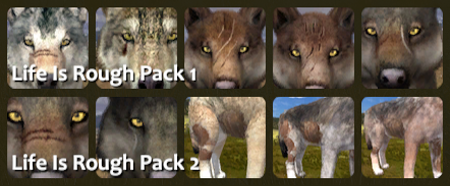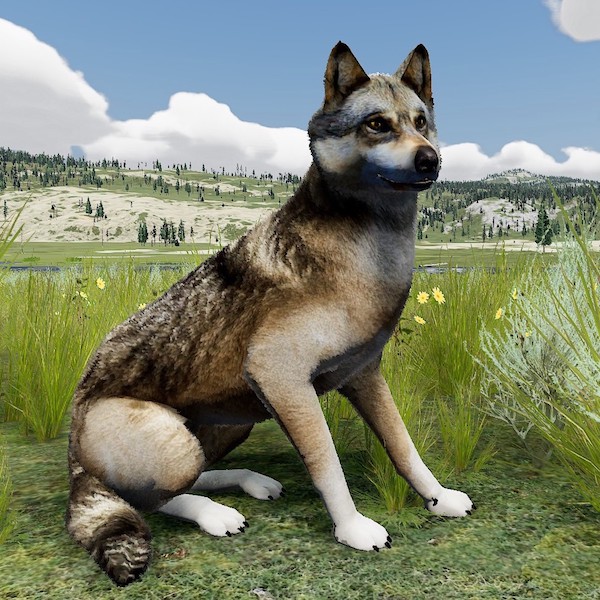Players can choose from more than 25 coat textures, modifiable with tints. Plus there are "Life is Rough" options for the Lamar Canyon Pack and Blacktail Deer Plateau Pack coats, modified to display injuries, scars, and afflictions. Fifteen additional "Yellowstone Wolf Coats" are available as DLC, and another ten coats in the "Building Character" DLC.
Players can also select from a range of realistic eye colors, modify size/body shape, and choose from various ear issues, or add a radio collar. Learn more about Wolf Customization.
Yellowstone Wolf Coats
Original Coats
Five original coats from classic WolfQuest updated for WolfQuest: Anniversary Edition.
Lamar Canyon Pack
Five coats based on wolves from the Lamar Canyon Pack (https://www.yellowstonewolf.org)
Blacktail Deer Plateau Pack
Five coats based on wolves from the Blacktail Deer Plateau Pack (https://www.yellowstonewolf.org)
Life is Rough
Lamar Canyon Pack and Blacktail Deer Plateau Pack coats, modified to display injuries, scars, and afflictions. Because wolf life is rough!
Classic Coats
Five classic coats from the original WolfQuest. Just as they were so you can get your nostalgia on.
Wolf Ambassadors
International Wolf Center
Since the beginning of WolfQuest, the International Wolf Center has been one of our science advisors, providing us with essential wolf behavior information that we've incorporated into all aspects of the game. We honor this connection with five wolf coats, inspired by a few of their beloved wolf ambassadors, past and present.
Aidan
2008-2019
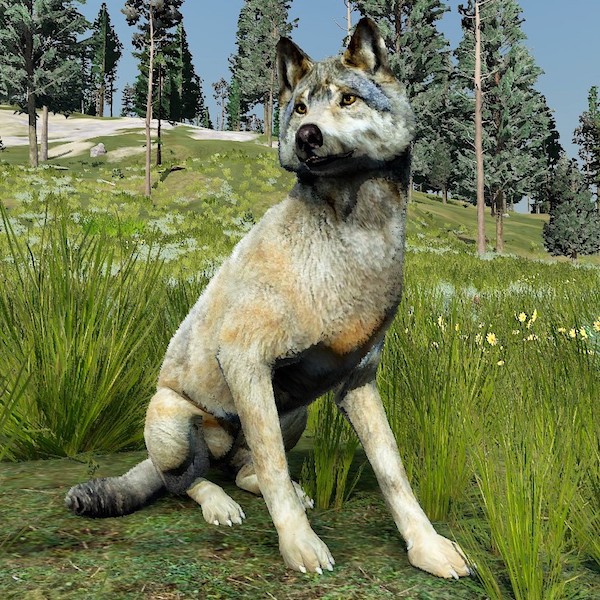
His demeanor was one of seriousness and intensity that provided an incredible strength in leadership of the Exhibit Pack from 2011 – 2018. “Regal” is one of the best words that best describes Aidan’s presence in the pack and to visitors. His pronounced “wolf-mask” face and the intensity of alert ears pricked forward showed a wolf that was always tuned in to any potential threat to his pack. It was that alertness and protective nature that made adopted pups feel so secure in Aidan’s presence.
***************
Boltz
2012-2020
Boltz was born in Sandstone, Minnesota in 2012 and while not a true littermate, was a pup mate to Luna. Knowing Luna’s tendency for dominance and food possession, Boltz developed a low-ranking status in the pack.
In addition to lack of status, he developed a phobia about summertime insects, particularly wasps, hornets, and bees. When he heard something buzzing overhead, he would drop his head and retreat to the wooded portion of the enclosure. This certainly did not help his status, but IWC staff worked with him to desensitize him to flying objects. A bubble machine with bacon-flavored bubbles became a popular enrichment activity.
Boltz was a calm, social pack member that would wait and watch, before trusting a situation. His sandy-brown pelage blended well in the upper enclosure and his facial expressions of mistrust and caution made him a favorite of visitors that would comment on that classic wolf look.
***************
Grizzer
2004-2022
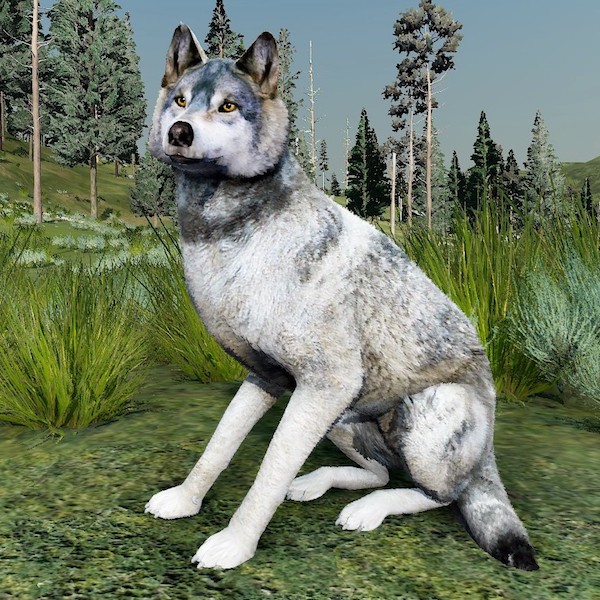
***************
Luna
2012-2019
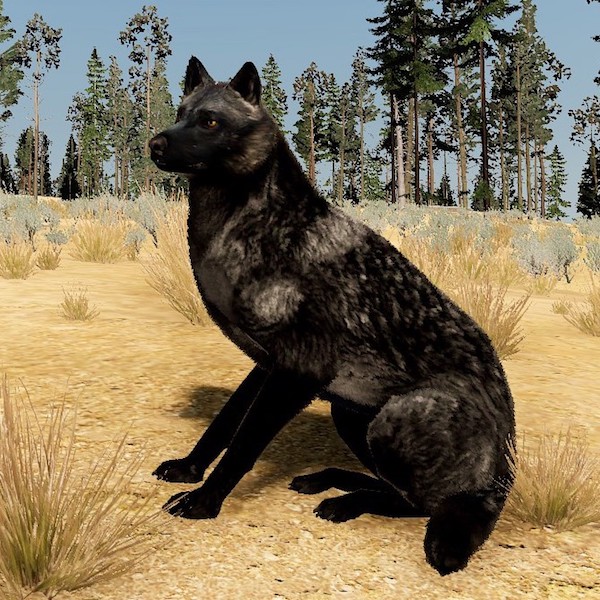
***************
MacKenzie
1993-2008
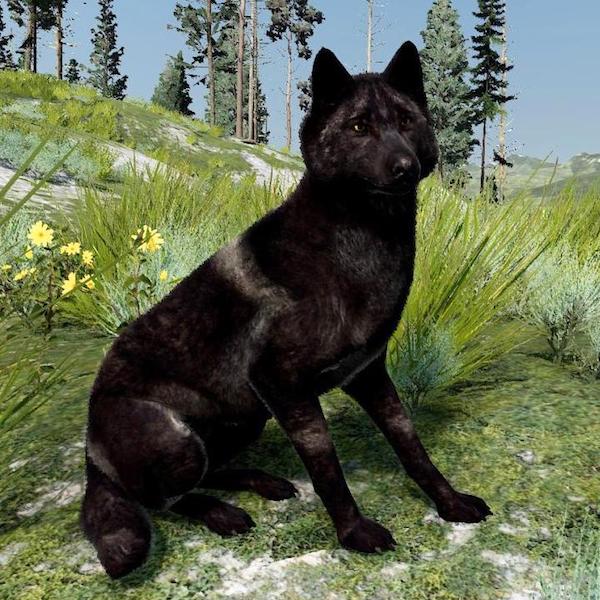
***************
Minnesota Browns
With the release of the game from Eary Access, we added another set of five wolf coats to the game: four of them are based on Ambasssdor Wolves at the International Wolf Center, and the fifth is based on a wolf in Voyageurs National Park who has been captured on trailcams by the Voyageurs Wolf Project.
Rieka
2021-present
Reika was born on May 23, 2021, and came to the International Wolf Center as a solo pup. She has a known lineage connection to wolves in British Columbia, Canada. When she was 79 days old, she weighed approximately 23 pounds, making her the smallest pup to be adopted by non-related adults. Despite her size, Rieka has a bold personality! Even though she was a singleton in 2021, she had the opportunity to socialize with the 2022 litter pups in a way that helped her grow into a more confident, dominant female in the Exhibit Pack. Rieka is always excited to see the wolf care team and interact with all pack members.
Blackstone
2022-present
Blackstone was born on April 6, 2022. He and his littermate, Caz, came to the International Wolf Center on May 10, 2022. They are both North American gray wolves (Canis lupus), and DNA sampling aligns them with wolves in the Yellowstone region. Blackstone is named in honor of Blackstone Lake in the Ely, Minnesota, area. He is known for his calm demeanor and usually interacts with his littermate, Caz. However, he may also seek reassurance from packmate Grayson if there are tensions within the pack, engaging in many social grooming behavior with the older wolf. Blackstone has been the larger of the two pups since his arrival. Blackstone is taller than his littermate and more cream-colored.
Caz
2022-present
Caz was born on April 6, 2022. He and his littermate, Blackstone, arrived at the International Wolf Center on May 10, 2022. Both are North American gray wolves (Canis lupus), and DNA sampling links them to wolves in the Yellowstone region. Caz’s name comes from a Celtic nickname meaning “watchful one” or “descended from the vigilant,” which initially reflected his personality, particularly regarding food. Caz is keenly aware of who possesses food and how he can strategize to acquire food. Caz is smaller than his brother but what he may lack in size, he makes up in attitude. He appears broader in the skull and muzzle compared to Blackstone and has a more grayish coat.
Denali
2008-2021
Denali and his brother Aidan were born at the Wildlife Science Center in Forest Lake Minnesota on April 27th, 2008 and came to the International Wolf Center as 12-day old pups.
Denali was fairly immune to dominance rank order. He was more prone to social engagement and avoided interactions related to dominance. His size and tendency to dominate food resources meant that Denali controlled who got to eat first in the weekly deer carcass feeding, allowing Boltz and Axel to feed with him but chasing Grayson away from the carcass until everyone else was full. This caused problems with pack dynamics and eventually led to Denali's retirement from the Exhibit Pack, when he was reunited with Grizzer, a former packmate and adapted to a calmer, more restful life in retirement.
In September 2021, wolf care staff noticed that Denali was significantly declining and all symptoms indicated some internal bleeding. He was euthanized by the Center’s Veterinarian later that night. A necropsy revealed the cause of his decline: a mass had ruptured on his liver. A biopsy confirmed that he had a hemangiosarcoma, and evidence suggested that this cancer had spread to other organs.
Y1T
2019 or 2020 - present
Wolf Y1T is the breeding male of the Blood Moon Pack in northern Minnesota. He was first collared in 2022 for study by the Voyageurs Wolf Project (VWP) when he was about 2-3 years old. Y1T (his research ID) stands for the information on his ear-tags he was given when he was collared. Y1T stands for YELLOW-ONE-TRIANGLE. The color (yellow) correlates to the pack territory he was captured in. The number lets VWP know what printed number is on the ear-tag (a “1” in this case), and the “T” stands for “Triangle”, which is the hand-drawn symbol on the end of the ear-tag. The color of the ear-tag and the hand-drawn symbol are unique to Y1T, and thus it makes it much easier for VWP to identify wolves like Y1T on camera very easily.
Y1T is one of the most distinctive-looking wolves in the Greater Voyageurs Ecosystem. His unique facial coloration includes dark lines under his eyes that give him a wild and striking appearance. VWP researchers have weighed him as 70-75 lbs – a bit bigger than the average male wolf in northern Minnesota. Y1T is also known for his specialization of hunting adult deer even in seasons when there is easier prey (such as beavers) to be had.
In the Winter of 2024-2025, Y1T’s mate for the past 3 years was killed by a neighboring pack. A little before his mate died, Y1T sustained a back leg injury somehow and was hobbling around on 3 legs for much of the winter as his leg healed. In March 2025, Y1T was seen on numerous occasions traveling with another female wolf indicating he had quickly found another mate. As of Summer 2025, Y1T was moving more effectively but he still had a bit of limp. Whether he full recovers from his injury remains to be seen but he seems to have no problem getting around despite the injury.
Thank you to Lori Schmidt, IWC Wolf Curator, and Tom Gable, Project Lead at Voyageurs Wolf Project, for their contributions to the ambassador and Voyaguers wolf bios.
International Wolf Center
The International Wolf Center, located in Minnesota, United States, advances the survival of wolf populations by teaching about wolves, their relationship to wildlands and the human role in their future. The International Wolf Center maintains a live wolf exhibit, featuring their Exhibit Pack to enhance both in-person and online educational experiences. These ambassador wolves contribute to the Center’s mission by reinforcing our educational messages and by creating a connection with each one of their visitors.




